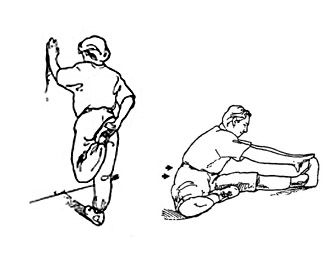Preventing
ACL Injuries in Women
In general,
musculoskeletal injuries are sports-specific rather than
gender specific. Injuries to the anterior cruciate ligament
(ACL), for example, occur frequently in soccer, basketball,
and volleyball. However, data collected since 1995 suggest
that ACL injury patterns are different in men and women who
participate in the same sport. The incidence of ACL injuries
among women basketball players is twice that for men, and
female soccer players are four times more likely to suffer
an ACL tear than their male counterparts. Both women and men
incur ACL injuries in non-contact situations. Nearly 60
percent of ACL injuries in female basketball players occur
when landing from a jump.
What is the
ACL?
The ACL is located inside the
knee joint and stabilizes the joint by preventing the
shinbone (tibia) from sliding forwards beneath the thighbone
(femur). A hard twist or excessive pressure on the ACL can
tear it, so that the knee gives out and can no longer
support the body.
Unless an injured ACL is
accurately diagnosed and treated, the cushioning cartilage
(the menisci) in the knee could be seriously damaged.
Without this cushion, the thighbone and the shinbone would
rub against each other, leading to further damage.
Studies have identified
several risk factors that contribute to a higher incidence
of ACL injuries among women athletes. Based on these
studies, training methods that could reduce the risk of
injury are now being developed.
Safer jumping skills
Because women don't bend
their knees as much as men do when landing from a jump, the
pressure on the knee joint is increased. The knee is exposed
to higher forces per pound of body weight. Learning to land
safely is a skill that can and should be taught early.
Cutting maneuvers
Women also turn and pivot in
a more erect position, which also strains the ACL. Learning
to crouch and bend at the knees and hips could reduce the
stress on the ACL. These maneuvers are motor skills that can
be learned, practiced and improved, just like a golf swing
or tennis stroke.
Muscle control techniques
The hamstring muscles in the
back of the thigh work with the quadriceps muscles in the
front of the thigh to bend or straighten the leg. As one set
contracts (shortens), the other relaxes (stretches). Muscles
that are being stretched produce more force than muscles
that are contracting.
Many women athletes use their
quadriceps muscles when they are changing direction rapidly.
This can put enough force on the shinbone to tear the ACL if
the knee isn't bent enough. By strengthening and using the
hamstrings rather than the quadriceps muscles, a female
athlete could reduce her risk of an ACL injury.
Prevention and treatment
Women athletes can take three
steps to reduce their risk of ACL injuries.
1. Training and conditioning
should be a year-round program. Skill drills and strength
and flexibility exercises will enhance balance and
coordination so you will be ready when the season starts.
2.
Make strengthening exercises for the hamstrings and
quadriceps muscles a regular part of your conditioning
program. To stretch the quads, stand and use a wall or table
for support. Lift one leg and pull your foot towards your
buttocks. Hold for five seconds, then release the foot and
stand straight. Repeat six to ten times on one side, then
turn and repeat on the other side. To stretch the
hamstrings, sit with one knee bent and the other leg
extended, toes pointing to the ceiling. Lean forward until
you feel a stretch. Hold for five seconds then return to
your original position. Repeat six to ten times on each leg.

3.
Practice proper landing technique (from a jump) and learn to
do cutting maneuvers in a crouched posture with a slight
bend at the knee and the hip.
If an ACL injury does occur,
it can often be successfully treated. Both operative and
nonoperative treatment options are available. Nonoperative
treatment can sometimes be used if the athlete is willing to
reduce her athletic participation.
An
athlete who wishes to return to sports that involve jumping,
cutting, and pivoting will probably need surgery to
reconstruct the ligament. This stabilizes the knee,
preserves the cartilage, and enables a return to sports at
the same level as prior to the surgery. Outcomes after
reconstruction are comparable between men and women with
high satisfaction and nearly identical success rates. After
surgery, exercise and rehabilitative therapy are required to
strengthen the muscles and restore mobility. Most athletes
can return to their chosen sport.
|